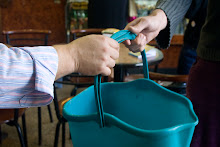.jpg)



____________________________________________________
São quase 18h e estou sentada no banco, em plena praça da Batalha, frente ao Teatro com o mesmo nome.
Tenho à minha frente um senhor de idade, curioso, que ainda não percebeu porque é que eu estou aqui sentada ao pé dele, escrevendo e filmando, com um computador no meu colo…Ele olha fixamente para tentar perceber o que faço e para onde olho, mas acaba por desviar o olhar para, talvez, tentar perceber o que estou a filmar, ou então simplesmente a situação deixa de o interessar...
A minha intervenção neste projecto é, neste momento, documentar o que se vai passando em torno de mim, aqui na praça, completando esta “comunidade física”, com a também legítima comunidade virtual.
Pretendo que esta tome conhecimento do projecto através do blog que eu privilegío enquanto o espaço público virtual por excelência, que permite o feedback constante por parte daqueles que o visitam, uma manifestação que, tal como em praça pública, também é possível.
Esta comunidade virtual, acaba por ser tanto aquela que viveu a experiência no espaço público real, como aquela que, por diversos e legítimos motivos não pôde estar presente mas pôde “visitar” o projecto que, sendo efémero, encontra no blog uma continuação.
Entendo este espaço da “web social” como mais do que uma simples forma de documentar a realidade social in situ.
Este espaço acaba por funcionar como um espaço público paralelo e específico, onde a intervenção aqui feita também “serve” uma comunidade - a virtual - que tem as suas especificidades, timings, prioridades e preconceitos também!
O projecto que aqui é desenvolvido acaba por transcender a intenção meramente documentativa, assumindo-se como “visão parcial” porque pessoal e mesmo voyerista de cada um dos intervenientes neste Bucket Project: seja através de um texto, de uma fotografia, de um excerto sonoro de uma conversa na rua ou uma coreografia.
Por isso a Emre me pediu para (se iríamos criar o blog como complemento do nosso Bucket Project) que o fizéssemos no próprio espaço público em plena praça da Batalha para desta forma viver o momento e tentar mostrar parte dele à comunidade virtual.
Vejo à minha volta algumas pessoas mas não lhes posso dar a atenção que quero nem tentar perceber as suas expressões e até curiosidade no que os meus colegas andam a fazer.
Tento ir observando e relatando o que vejo e estou com uma câmara compacta na mão (não sei como consigo fazer as duas coisas ao mesmo tempo!) para ir filmando em pequenos vídeos o que o João e a Joana estão a fazer neste momento.
Eles estão à minha frente a colocar os posters gigantes que foram impressos a preto e branco, com as fotografias tiradas pelo João durante a “recolha de baldes” na semana passada, em que fomos todos juntos a diversas lojas de comércio aqui da zona da Batalha, pedir alguns baldes para a nossa “colecção”.
Ao colocarem os posters eles parecem-me ser interceptados por algumas pessoas que passam por eles curiosas e olham bastante ou chegam a perguntar algo, mas não dá para perceber o quê…
Talvez porque as imagens tenham impacto e são suigéneris (por todas representarem pessoas a segurarem baldes nas mãos), ou também porque eles estão a colocar aqueles cartazes à luz do dia e nesta altura é raro ver movimentação naquelas vitrines com tanto “cola e descola” cartazes!
De qualquer das formas, esta acção que eles desenvolvem, este montar de uma exposição em espaço público entendendo a praça como galeria, acaba por ser um gesto performativo que queremos súbtil e que quase se pode camuflar nesta praça.
Entendo como uma “acção-site-specific” que se (con)funde com os gestos quotidianos desta comunidade da Batalha.
A curiosidade e o que mais “intriga” nesta acção, é o facto de, embora seja um gesto perfeitamente aceitável como parte (possível) de um quotidiano deste local, acaba por convocar situações de “déjà vu” ou até mesmo “déjà-non-vu” que obriga os transeuntes a olharem duas vezes e se questionarem: “Porque estarão estes jovens a colar cartazes a esta hora do dia?”; “Para quê tantas imagens de baldes?”. Ocorrem-me certas perguntas e tento colocar-me no lugar de um transeunte embora tenha noção que a minha atitude é extremamente especulativa...
E isto é o que vou observando na minha posição “viciada” de fruidora/produtora que ao ser participante neste projecto, não consegue de uma forma imparcial (nem tenho essa pretensão) me colocar na pele do observador passageiro e sem tempo para muito questionar...
A curiosidade e vontade de saber quais as ideias e opiniões que o público portuense da zona downtown do Porto tem acerca da arte e das suas formas de se assumir no espaço público, levou-nos a entender a procura dos baldes como uma “busca” de uma série de feedbacks que de certa forma sintetizamos nesta “desculpa do balde”.
Para isso decidimos ir directamente contactara comunidade que seria, daí a uma semana, o público circundante que iria “receber” este nosso projecto de intervenção específica na praça da Batalha.
Ficam aqui algumas intenções, intervenções e especulações, e fica também este espaço como um livro de visitas virtual, um projecto que reúne informação lado a lado com a possibilidade de comentário e de (re)acção por parte de qualquer “transeunte virtual” que, mais ou menos apressado, aqui queira deixar o seu comentário, mais ou menos simpático, mais ou menos preconceituoso, mais ou menos especializado, mais ou menos previsível! Tal como também acontece na rua, este espaço é legítimo por tratar-se de um espaço público como outro qualquer, onde podemos encontrar de tudo um pouco, não é verdade? :)
Não tenho mais tempo para escrever pois o Jorge começa de seguida a performance com os baldes na fonte-fantasma! Obrigada pela visita! Sintam-se à vontade para comentar aqui ou através do e-mail: bucket.project08 [arroba] gmail [ponto] com
Apareçam de novo amanhã, virtual ou físicamente! :)
Manuela São Simão
____________________________________________________
____________________________________________________Clik HERE for a slide-show of images by João Pádua.____________________________________________________














.jpg)














